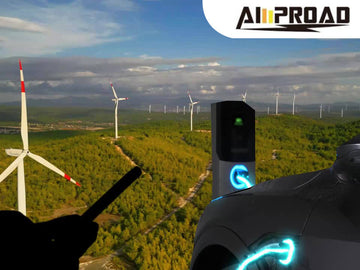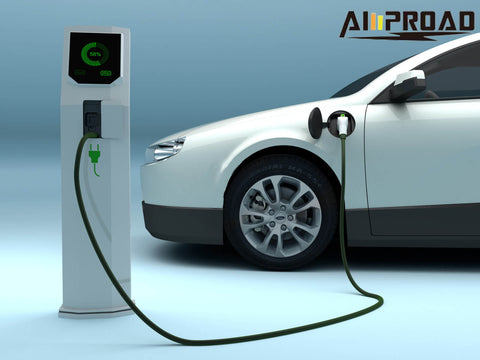
Electric vehicles, or EVs, are zooming onto the scene, thanks to their eco-friendly nature and lower running costs. Unlike gasoline-powered cars, EVs rely on electricity to power their motors. To keep your EV topped up conveniently at home, you'll need a home EV charger. Just like filling up a tank with gas, but at home and overnight, an EV charger keeps your electric car charged and ready to go. Choosing the right home charger depends on your needs and driving habits, so let's explore the different types available to find the perfect fit for you!
Main Types of Home EV Chargers
Level 1 Charger (Slow Charging)
Level 1 chargers are designed to plug into standard 120-volt household outlets, providing basic charging capability for EV owners without requiring additional installation.
Charging Speed: With a charging rate of approximately 3 to 5 miles of range per hour, Level 1 chargers offer the slowest charging option among residential charging solutions.
Advantages:
- Convenience: Level 1 chargers are often included with the purchase of an electric vehicle, allowing for immediate use without the need for additional equipment or installation.
- Accessibility: Since they utilize standard household outlets, Level 1 chargers are accessible to most EV owners, regardless of their home's electrical setup.
- Cost-effectiveness: The simplicity of Level 1 chargers makes them a cost-effective solution for EV owners with modest daily driving needs, particularly for overnight charging.
Disadvantages:
- Slow Charging Times: Due to their lower power output, Level 1 chargers are not suitable for rapid charging or for EV owners with higher mileage requirements.
- Limited Range Extension: The modest charging rate of Level 1 chargers may not adequately meet the needs of EV owners who rely on their vehicles for extended travel or frequent long-distance trips.
Level 2 Charger (Faster Charging)
Level 2 chargers require a 240-volt electrical supply, typically installed by a professional electrician. They offer significantly faster charging speeds compared to Level 1 chargers.
Charging Speed: Level 2 chargers can add approximately 15 to 30 miles of range per hour, depending on the vehicle and charger specifications, making them a more efficient charging solution for EV owners.
Advantages:
- Rapid Charging: With faster charging times, Level 2 chargers provide greater convenience and flexibility for EV owners, especially those with higher daily mileage or longer commutes.
- Enhanced Versatility: Level 2 charger is suitable for various EV models and can accommodate multiple vehicles within a household, making them a scalable charging solution for growing EV fleets.
Integration with Smart Home Systems: Many Level 2 chargers offer advanced features, such as Wi-Fi connectivity and smartphone apps, allowing users to monitor and control charging remotely.
Disadvantages:
- Installation Requirements: Installing a Level 2 charger involves professional electrical work and may require upgrades to your home's electrical panel or wiring, adding to the initial cost.
- Infrastructure Limitations: While Level 2 chargers offer faster charging speeds, their effectiveness may be limited by the availability of compatible electrical infrastructure, particularly in older homes or apartment buildings.
Home EV chargers play a vital role in supporting the transition to electric mobility, providing EV owners with convenient and efficient charging solutions. When choosing between Level 1 and Level 2 chargers, it's essential to consider factors such as charging speed, installation requirements, and long-term charging needs. By understanding the characteristics and trade-offs of each charging option, you can select the most suitable charger to meet your EV charging requirements and enhance your overall ownership experience.
Additional Considerations
Charger Plugs (J1772, Tesla, etc.)
Electric vehicles (EVs) come with various charging plug types, each designed to accommodate different charging standards and vehicle models. Two common plug types include the J1772 connector and the Tesla connector.
- J1772 Connector: This plug type is a standard in the EV industry and is used by many non-Tesla electric vehicles. It features a round, five-pin design and is compatible with most Level 1 and Level 2 EV charger.
- Tesla Connector: Tesla vehicles use a proprietary connector designed specifically for their charging infrastructure. While Tesla vehicle come with an adapter for J1772 charger, Tesla's own Supercharger network utilizes a unique connector for rapid charging.
Understanding the compatibility of charger plugs is essential when selecting a home EV charger. If you own a Tesla vehicle, you may need to consider compatibility with both Tesla's proprietary connector suach as for the Tesla destination charger, and the standard J1772 connector for charging versatility.
Factors to Consider When Choosing a Charger
Several factors should be taken into account when choosing a home EV charger to ensure it meets your specific needs and preferences:
- Battery Size: Consider the battery size of your EV, as larger batteries may require more charging time and a higher-powered charger for optimal performance.
- Driving Habits: Evaluate your typical driving habits, including daily mileage and frequency of long-distance trips. This will help determine the charging speed and convenience required from your home charger.
- Budget: Set a budget for your home EV charger, taking into account not only the initial purchase cost but also any potential installation expenses and long-term operating costs.
- Charging Speed: Assess the charging speed offered by different charger models and consider whether it aligns with your charging needs and lifestyle.
- Smart Features: Some home EV chargers come with advanced features such as scheduling, remote monitoring, and integration with smart home systems. Evaluate these features based on your preferences for convenience and control over your charging setup.
- Compatibility: Ensure compatibility between your chosen charger and your EV model, considering both plug type and charging standards to avoid any compatibility issues.
By carefully considering these factors, you can select a home EV charger that meets your specific requirements, enhances your EV ownership experience, and provides reliable and efficient charging for your electric vehicle.
This concise yet informative content provides valuable insights into additional considerations for home EV charging, covering charger plug types, compatibility, and key factors to consider when choosing a charger. With this knowledge, EV owners can make informed decisions to optimize their home charging setup for convenience, efficiency, and cost-effectiveness.
Choosing the Right Home EV Charger

Selecting the right home EV charger is crucial for maximizing the convenience and efficiency of electric vehicle ownership. Let's recap the main types of home EV chargers and their respective advantages and disadvantages, highlighting the importance of choosing the right charger for your specific needs.
Home EV chargers come in two primary types: Level 1 (Slow Charging) and Level 2 (Fast Charging).
Level 1 Charger:
- Pros: Convenient and accessible, requiring no installation and often included with EV purchases. Ideal for overnight charging of low-mileage vehicles.
- Cons: Slow charging times may not meet the needs of high-mileage EV owners or those requiring rapid recharging.
Level 2 Charger:
- Pros: Offers faster charging times and greater flexibility, suitable for most daily driving needs. Can accommodate multiple EVs and provides convenience for longer trips.
- Cons: Requires professional installation and may involve additional electrical work, increasing initial costs.
It's essential to choose the right charger based on your specific requirements, taking into account factors such as daily driving habits, vehicle range, and available electrical infrastructure. Consideration should also be given to factors such as budget, charging speed, and compatibility with your EV model.
One notable option to consider is the AMPROAD Level 1 & Level 2 DUAL USE EV charger. This versatile charger offers the convenience of both Level 1 and Level 2 charging capabilities in a single unit. With its ability to plug into a standard 120-volt household outlet for Level 1 charging or connect to a 240-volt outlet for Level 2 charging, it provides flexibility for various charging needs.
By understanding the differences between Level 1 and Level 2 chargers and evaluating your individual needs, you can select the most suitable charger to support your EV ownership experience. Whether you prioritize simplicity and convenience with a Level 1 charger or require the faster charging speeds of a Level 2 charger for your daily commute, choosing the right charger ensures reliable and efficient charging for your electric vehicle.
FAQs / People Also Ask
What are the main types of home EV chargers available?
The main types of home EV chargers are Level 1 (Slow Charging) and Level 2 (Fast Charging). Level 1 chargers plug into a standard 120-volt outlet and provide slow charging rates, while Level 2 chargers require a 240-volt outlet and offer faster charging speeds.
What is the difference between Level 1 and Level 2 chargers?
The primary difference between Level 1 and Level 2 chargers lies in their charging speed and power requirements. Level 1 chargers are slower and require no installation, whereas Level 2 chargers provide faster charging but require professional installation and a dedicated 240-volt outlet.
What are the advantages of Level 1 chargers?
Level 1 chargers are convenient, as they often come included with EV purchases and require no additional installation. They are suitable for overnight charging of low-mileage vehicles and can be plugged into standard household outlets without the need for modifications.
What are the disadvantages of Level 1 chargers?
The main disadvantage of Level 1 chargers is their slow charging times, which may not meet the needs of EV owners with higher mileage requirements or those who need rapid recharging.
What are the advantages of Level 2 chargers?
Level 2 chargers offer faster charging times, making them suitable for most daily driving needs. They can add significant range to an EV in a shorter amount of time compared to Level 1 chargers.
What are the disadvantages of Level 2 chargers?
The primary disadvantage of Level 2 chargers is the requirement for professional installation and potentially additional electrical work, which can increase initial costs. Additionally, not all homes may have the necessary electrical infrastructure to support Level 2 charging.
Are there any other charger options available?
Yes, some chargers, like the AMPROAD Level 1 & Level 2 DUAL USE EV charger, offer both Level 1 and Level 2 charging capabilities in a single unit. These chargers provide flexibility for various charging needs and can be a convenient option for EV owners seeking versatility in their home charging setup.



